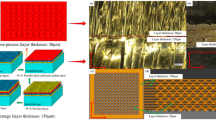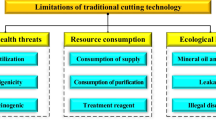Abstract
Borosilicate glass has good light transmittance and stable chemical property, which is an ideal material for microfluidic chip matrix, However, brittle fracture is easy to occur during processing, which is a typical material difficult to process. This limits the surface accuracy. In recent years, longitudinal torsional ultrasonic vibration–assisted milling (LTUVAM) has been proposed as an effective way to machine hard and brittle materials. To elucidate the mechanism of material removal methods and elaborate the material removal mechanism during longitudinal torsional ultrasonic vibration–assisted milling process, this paper established a 3D morphology prediction model to investigate the material removal method. Firstly, the three-dimensional surface morphology model was created by describing the intricate tool path and the workpiece surface morphology reconstruction process under ultrasonic conditions while also considering the tool run-out effect. The model exhibited a certain degree of scalability, enabling the acquisition of various process morphology prediction models by altering the tool coordinates via matrix manipulation. Secondly, the accuracy of the model was verified by longitudinal torsional ultrasonic processing experiments. Thirdly, longitudinal torsional ultrasonic vibration–assisted milling experiments and longitudinal ultrasonic vibration–assisted milling experiments were conducted, and the surface roughness of the machined workpieces was measured. The experimental results show that LTUVAM further reduces the roughness compared with LUVAM, indicating that the reduction ratio reaches a maximum value of 61.06% at the spindle speed of 16,000 RPM, and then, the reduction ratio decreases to 42.88% with the increase of spindle speed. Combining modeling and experimental results, we concluded that LTUVAM was more advantageous in achieving plastic material removal and enhancing the surface quality of the machined surface compared to LUVAM. And under the same process conditions, as the spindle speed increases, the surface roughness of the workpiece increases first and then decreases.



















Similar content being viewed by others
Data availability
The datasets used or analyzed during the current study are available from the corresponding author on reasonable request.
References
El-Taybany Y, Hossam M, El-Hofy H (2017) Experimental investigation of ultrasonic-assisted milling of soda glass using factorial design of experiments. Procedia CIRP 58:381–386. https://doi.org/10.1016/j.procir.2017.03.238
Antwi EK, Liu K, Wang H (2018) A review on ductile mode cutting of brittle materials. Front Mech Eng 13:251–263. https://doi.org/10.1007/s11465-018-0504-z
Chen F, Mei GJ, Zhao B, Bie WB, Li GX (2020) Study on the characteristics of zirconia ceramic in three-dimensional ultrasonic vibration-assisted ELID internal grinding. J Mech Sci Technol 34:333–344. https://doi.org/10.1007/s12206-019-1233-x
Gu G, Wu S, Wang D, Zhou S, Zhu LD (2023) An QL, Guo H. A review of the research on the variation of tool’s motion trajectory and its influence on the formation mechanism of surface quality in ultrasonic vibration machining. J Manuf Process 107:294–319. https://doi.org/10.1016/j.jmapro.2023.10.025
Chen J, An QL, Ming WW, Chen M (2020) Investigation on machined surface quality in ultrasonic-assisted grinding of C f/SiC composites based on fracture mechanism of carbon fibers. Int J Adv Manuf Technol 109:1583–1599. https://doi.org/10.1007/s00170-020-05739-3
Zhang JG, Zhang JJ, Cui T, Hao ZW, Zahrani AA (2017) Sculpturing of single crystal silicon microstructures by elliptical vibration cutting. J Manuf Process 29:389–398. https://doi.org/10.1016/j.jmapro.2017.09.003
Liu J, Chen G, Ren C, Qin X, Zou Y, Ge J (2020) Effects of axial and longitudinal-torsional vibration on fiber removal in ultrasonic vibration helical milling of CFRP composites. J Manuf Process 58:868–883. https://doi.org/10.1016/j.jmapro.2020.08.071
Layegh KSE, Lazoglu I (2017) 3D surface topography analysis in 5-axis ball-end milling. CIRP Ann 66(1):133–136. https://doi.org/10.1016/j.cirp.2017.04.021
Buj-Corral I, Vivancos-Calvet J (2011) González-Rojas H (2011) Influence of feed, eccentricity and helix angle on topography obtained in side milling processes. Int J Mach Tools Manuf 51(12):889–897. https://doi.org/10.1016/j.ijmachtools.2011.08.001
Song W, Liu Z, Yao G, Khan AM, Cai Y (2022) Effect of workpiece work hardening on machined surface topography generated in two-step milling process. J Manuf Process 77:348–360. https://doi.org/10.1016/j.jmapro.2022.03.039
Lu XH, Hu XC, Jia ZY, Liu MY, Gao S, Qu CL, Liang SY (2018) Model for the prediction of 3D surface topography and surface roughness in micro-milling Inconel 718. Int J Adv Manuf Tech 94:2043–2056. https://doi.org/10.1007/s00170-017-1001-y
Yang D, Liu ZQ (2015) Surface plastic deformation and surface topography prediction in peripheral milling with variable pitch end mill. Int J Mach Tool Manu 91:43–53. https://doi.org/10.1016/j.ijmachtools.2014.11.009
Cai CY, An QL, Chen M, Ming W (2023) Modelling of end-milled floor surface topography considering system vibration and tool deflection. J Mater Process Tech 312:117864. https://doi.org/10.1016/j.jmatprotec.2023.117864
Arizmendi M, Jiménez A (2019) Modelling and analysis of surface topography generated in face milling operations. Int J Mech Sci 163:105061. https://doi.org/10.1016/j.ijmecsci.2019.105061
Wang LP, Ge SY, Si H, Guan LW, Duan FY, Liu YZ (2020) Elliptical model for surface topography prediction in five-axis flank milling. Chinese J Aeronaut 33(4):1361–1374. https://doi.org/10.1016/j.cja.2019.06.007
Wang LP, Ge SY, Si H, Yuan X, Duan FY (2020) Roughness control method for five-axis flank milling based on the analysis of surface topography. Int J Mech Sci 169:105337. https://doi.org/10.1016/j.ijmecsci.2019.105337
Wang T, Wu XY, Zhang GQ, Xu B, Chen YH, Ruan SC (2021) Theoretical study on frequency spectrum characteristics of surface profiles generated in micro-end-milling process. Int J Adv Manuf Tech 113(3–4):893–906. https://doi.org/10.1007/s00170-021-06686-3
Juri AZ, Belli R, Lohbauer U, Ebendorff-Heidepriem H, Yin L (2023) Edge chipping damage in lithium silicate glass-ceramics induced by conventional and ultrasonic vibration-assisted diamond machining. Dent Mater 39(6):557–567. https://doi.org/10.1016/j.dental.2023.04.001
Zhang CL, Feng PF, Zhang JF (2013) Ultrasonic vibration-assisted scratch-induced characteristics of C-plane sapphire with a spherical indenter. Int J Mach Tool Manu 64:38–48. https://doi.org/10.1016/j.ijmachtools.2012.07.009
Huang WH, Yu DP, Zhang XQ, Zhang M, Chen DS (2018) Ductile-regime machining model for ultrasonic elliptical vibration cutting of brittle materials. J Manuf Process 36:68–76. https://doi.org/10.1016/j.jmapro.2018.09.029
Zhang JG, Zhang JJ, Cui T, Al HZW, Zahrani A (2017) Sculpturing of single crystal silicon microstructures by elliptical vibration cutting. J Manuf Process 29:389–398. https://doi.org/10.1016/j.jmapro.2017.09.003
Juri AZ, Song XF, Nakanishi Y, Dudley J, Jamieson L, Yin L (2023) Surface fractures in pre-crystallized and crystallized zirconia-containing lithium silicate glass-ceramics generated in ultrasonic vibration-assisted machining. J Mech Behav Biomed 147:106132. https://doi.org/10.1016/j.jmbbm.2023.106132
Qin SQ, Zhu LD, Wiercigroch M, Ren TY, Hao YP, Ning JS, Zhao JZ (2022) Material removal and surface generation in longitudinal-torsional ultrasonic assisted milling. Int J Mech Sci 227:107375. https://doi.org/10.1016/j.ijmecsci.2022.107375
Funding
The authors wish to acknowledge the financial support for this research from the Post-doctoral Later-stage Foundation Project of Shenzhen Polytechnic University (Project No. 6021271001 K), the Natural Science Foundation of Shandong Province (Grant No. ZR2020QE180), the Key Research and Development Plan of Shandong Province (No. 2023CXPT014 and 2021JMRH0301), the Visiting Study and Training of Teachers from Provincial General Undergraduate Universities in Shandong Province, and the Domestic Visiting Scholar of Shandong Jianzhu University.
Author information
Authors and Affiliations
Contributions
All authors participated in the work of the paper. J.Y.: conceptualization, methodology, writing—review and editing, funding acquisition. X.L.: supervision, writing—original draft, methodology. T.W.: supervision, methodology, writing—review and editing, funding acquisition. Q.S.: supervision, methodology. W.C.: methodology, funding acquisition. T.G.: supervision, analysis. Y.S.: analysis. All authors have read and agreed to the published version of the manuscript.
Corresponding author
Ethics declarations
Ethics approval
Not applicable.
Consent to participate
The authors declare that they participated in this research work.
Consent for publication
The authors declare that they agreed to publish the research results.
Conflict of interest
The authors declare no competing interests.
Additional information
Publisher's Note
Springer Nature remains neutral with regard to jurisdictional claims in published maps and institutional affiliations.
Rights and permissions
Springer Nature or its licensor (e.g. a society or other partner) holds exclusive rights to this article under a publishing agreement with the author(s) or other rightsholder(s); author self-archiving of the accepted manuscript version of this article is solely governed by the terms of such publishing agreement and applicable law.
About this article
Cite this article
Yi, J., Liu, X., Wang, T. et al. Surface quality study of longitudinal torsional ultrasonic micro-milling of borosilicate glass based on morphological modeling. Int J Adv Manuf Technol (2024). https://doi.org/10.1007/s00170-024-13753-y
Received:
Accepted:
Published:
DOI: https://doi.org/10.1007/s00170-024-13753-y




